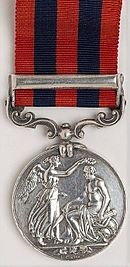India General Service Medal (1854) facts for kids
The India General Service Medal (also called the 1854 IGSM) was a special award given to soldiers. It was approved on March 1, 1854. This medal was for officers and soldiers in the British Army and British Indian Army. They earned it for taking part in various small military campaigns. These events happened in India and nearby countries between 1852 and 1895.
In 1852, a leader named Lord Dalhousie suggested this medal. He wanted to create one general medal for smaller Indian campaigns. This would mean fewer different medals were given out.
Most of the soldiers in these campaigns were from the British Indian Army. The missions often took place in tough areas. Soldiers faced strong resistance from local tribes. Even though there were not many big battles, the fighting was hard.
In 1895, a new medal called the India Medal was created. It replaced the 1854 General Service Medal. The new medal covered service in later Indian expeditions.
What the Medal Looked Like
The medal was about 3.6 centimeters (1.4 inches) across. It was made at the Royal Mint. At first, only silver medals were given. Later, bronze medals were also awarded. These bronze medals went to local helpers. This included people like bearers, sweepers, and drivers. They supported the troops during campaigns like Burma 1885–87.
The front of the medal is called the obverse. It showed a picture of Queen Victoria facing left. She was wearing a special crown called a diadem. Around her head, it said "VICTORIA REGINA".
The back of the medal is called the reverse. It showed a goddess named Victory. She was placing a laurel wreath (a crown of leaves) on a seated warrior. At the bottom, there were lotus flowers and leaves. This area is called the exergue.
Each medal had the soldier's rank, name, and unit carved or stamped on its edge. The medal hung from a fancy scrolled bar.
The medal's ribbon was about 3.2 centimeters (1.25 inches) wide. It had five stripes. Three stripes were red, and two were dark blue. Each stripe was about 0.6 centimeters (0.25 inches) wide.
What are Clasps?
A clasp is a metal bar attached to the medal's ribbon. Each clasp showed that a soldier took part in a specific campaign. A total of 24 clasps were given out for 23 different campaigns. If a soldier earned more than one clasp, they only received the new clasp. They would attach it to their medal. No medal was ever given without at least one clasp. The most clasps known on one medal was seven.
Here are some of the clasps that were issued:
- Pegu (2nd Burmese War, 1852–53)
- Persia (Persian War, 1856–57)
- North West Frontier (Various small expeditions, 1849–68)
- Umbeyla (N. W. Frontier, 1863)
- Bhootan (Bhutan War, 1864–66)
- Looshai (N. E. India, 1871–72)
- Perak (Malayan coast, 1875–76)
- Jowaki 1877–78 (N. W. Frontier)
- Naga 1879–80 (N. W. Burma)
- Burma 1885–7 (3rd Burmese War).
- Sikkim 1888 (N. E. India)
- Hazara 1888 (Black Mountain Expedition, N. W. Frontier)
- Burma 1887–89 (Some clasps inscribed Burma 1887–9)
- Chin Lushai 1889–90 (India-Burma border)
- Lushai 1889–92 (India-Burma border)
- Samana 1891 (Miranzai Expedition, N. W. Frontier)
- Hazara 1891 (2nd Black Mountain Expedition, N. W. Frontier)
- NE Frontier 1891 (Manipur, India-Burma border)
- Hunza 1891 (Northern Frontier)
- Burma 1889–92 (Small local operations)
- Chin Hills 1892–93 (N. W. Burma)
- Kachin Hills 1892–93 (Northern Burma)
- Waziristan 1894–95 (N. W. Frontier)
After the first part of the Second Anglo-Afghan War in May 1879, there was a plan. It was suggested that the India General Service Medal should have clasps for Afghanistan, Ali Musjid, and Peiwar Kotal. However, the war started again in September 1879. So, it was decided to create a completely separate medal. This new medal was called the Afghanistan Medal. It covered the entire Afghan War.




